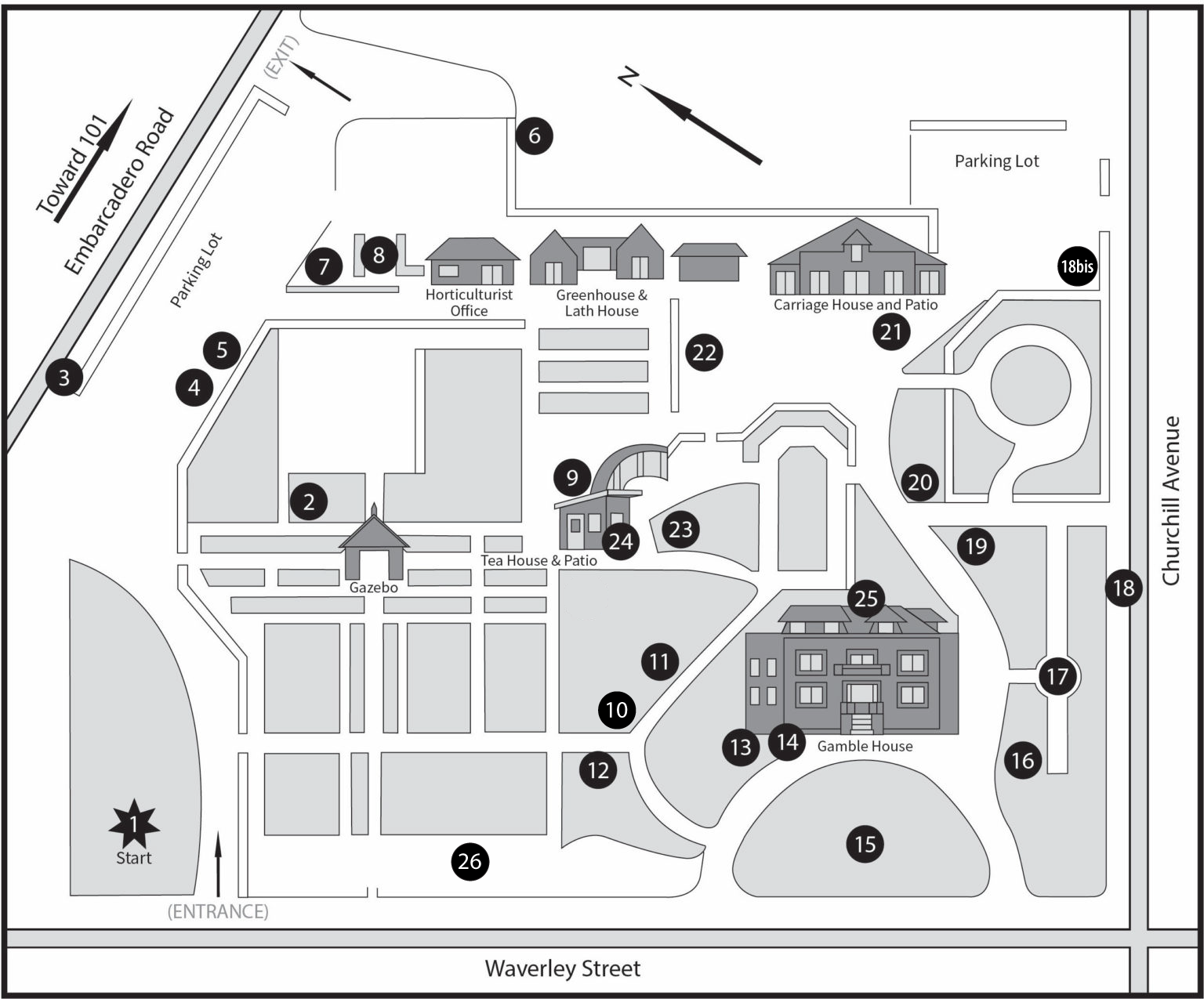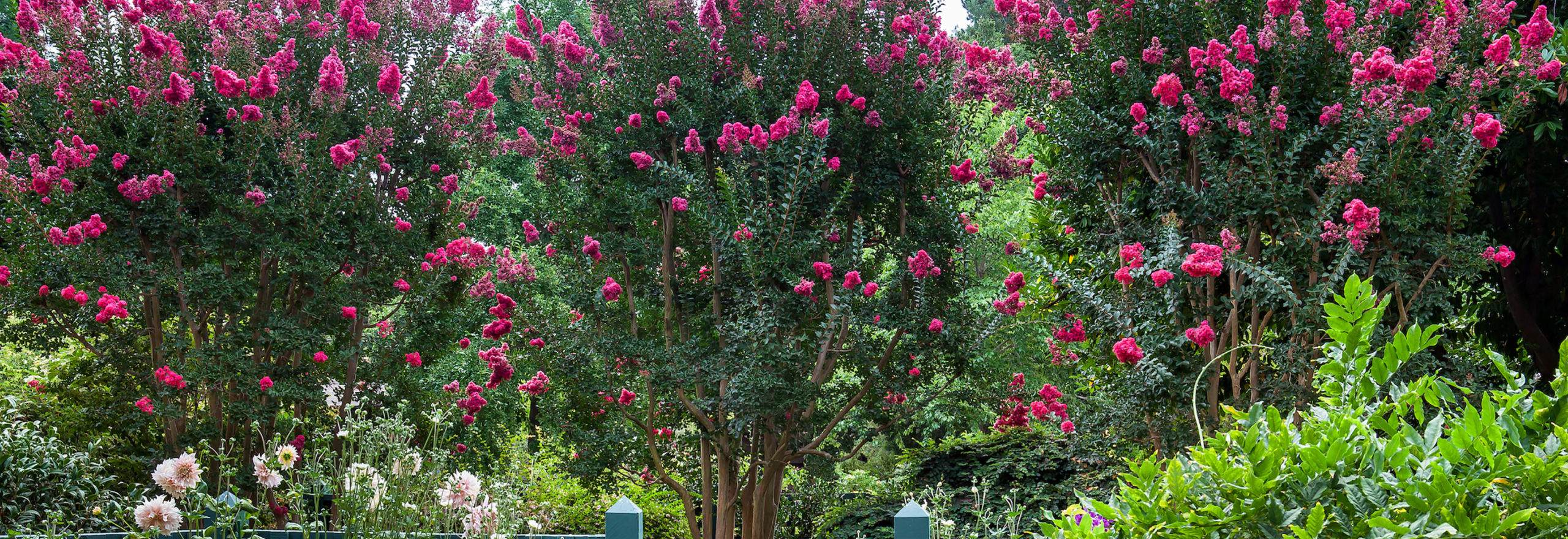
Trees of Gamble Garden
On this walk, we will visit over twenty of our signature trees, some dating back to Elizabeth Gamble's days. Depending on when you visit, the trees may be showing their spring blooms, summer fruit, or fall colors. It will take about 30-45 mins to see all of the trees on the tour.
This self-guided walk is based on a tour and brochure developed by Canopy.org, the area's leading urban forestry group, which has written the bulk of the text below. Gamble Garden volunteers and staff provided additional text and the photos.
The Elizabeth F. Gamble Garden Tree Walk begins at the Parking Lot near the corner of Waverley Street and Embarcadero Road.
1. Manna Gum (Eucalyptus viminalis)
Walk down Waverley toward Embarcadero and turn into the driveway leading to the parking lot. Stop at the opening in the fence at the edge of the garden.

One of several gigantic manna gums along Embarcadero Road, this Australian native has lengthy ribbons of sunburnt bark that peel to reveal fresh white trunk. Insignificant white flowers occur throughout the year, but are usually too high to be seen. Pea-sized seed capsules produce year-round litter.
Ironically, this large tree is in our Native California garden – even though it is not a native. In fact, eucalyptus is an invasive species first brought to California in the 19th Century. The trees were prized for their rapid growth and were planted as windbreaks on farms and in large ‘forests’ in the hopes that the trees could provide lumber and railroad ties for the state’s explosive growth. Unfortunately, eucalyptus wood has an uneven grain and it bent, cracked and shrank after having been cut. It couldn’t even be used for fence posts or railroad ties because it decayed quickly. Today, eucalyptus groves cover millions of acres in Northern California and are of little commercial value. Their exfoliating (shedding) bark and high oil content make them especially susceptible to fires. The eucalyptus stands as a monument to good intentions gone bad.
2. Akebono (Yoshino) Cherry (Prunus x yedoensis ‘Akebono’)
Enter the garden and immediately turn left and walk on the path along the fence. Stop at the second opening.
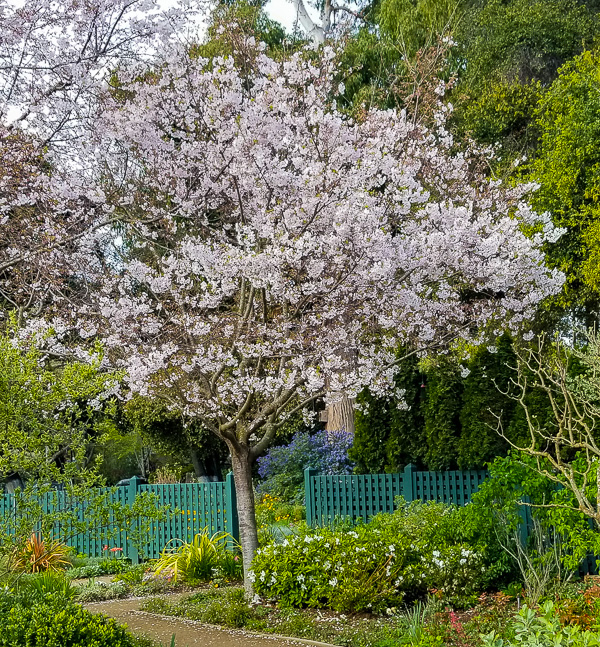
In March, these two ornamental cherry trees are covered in a cloud of pink, fragrant blooms. This hybrid, non-fruiting tree was introduced from Japan in 1902, and is the most common flowering cherry tree planted in Washington, D.C.
3. California Buckeye (Aesculus californica)
Walk into the parking lot and look straight ahead towards Embarcadero Road.
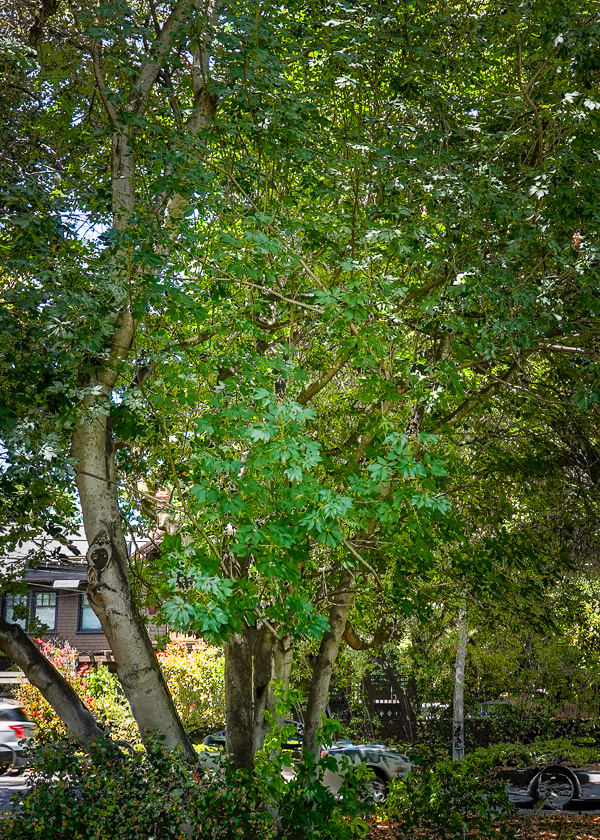
A multi-trunk tree at the edge of the parking lot near the handicap parking space. It is in the same genus as the American chestnut and is the only species of the genus native to the West. The 6” creamy-white flower spikes appear in April and May. This native tree is among the first to leaf out in spring and the first to lose its leaves in mid-summer. In the summer months, you’ll see the bare-branched trees along US 280 in Palo Alto with hanging husks containing seeds.

The trees are very long-lived with lifespans of 250-280 years.
The nuts or seeds are poisonous, and the nectar and pollen are toxic to honeybees.

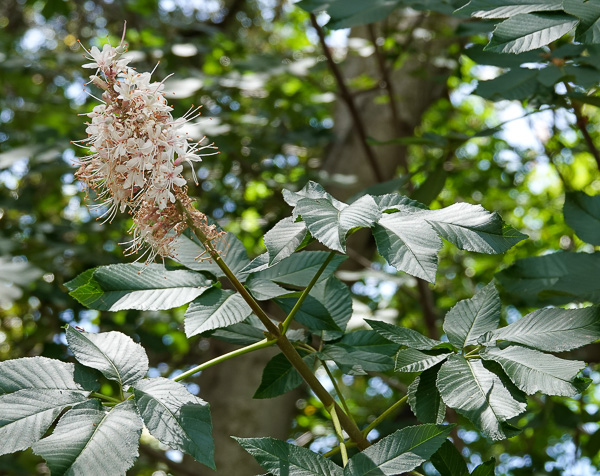
Native Americans used the poison to paralyze schools of fish in small streams to make them easier to catch. Native groups boiled the seeds to leach out the toxins and the nuts could then be ground into a flour similar to acorn flower.
4. Cucumber Tree (Magnolia acuminata ‘Golden Glow’)
Turn right and continue in the parking lot, stopping before you reach the third opening into the garden.
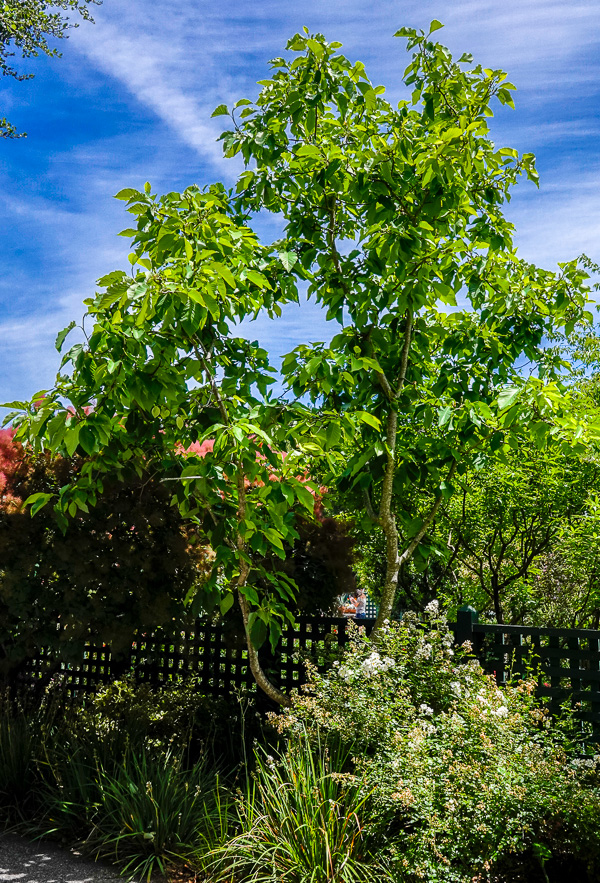
Unusual for this area, the cucumber tree is native to eastern North America. Once it reaches 12 years, it has unremarkable yellow flowers high on the tree in the late spring, followed by green fruits that are shaped like a small cucumber. The fruits mature to a dark red color and split open to release red seeds.
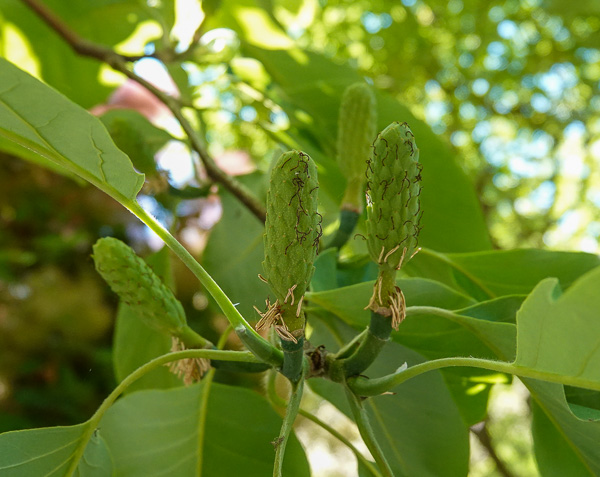
5. Smoke Tree (Cotinus coggygria)
This tree is just to the left of the cucumber tree.
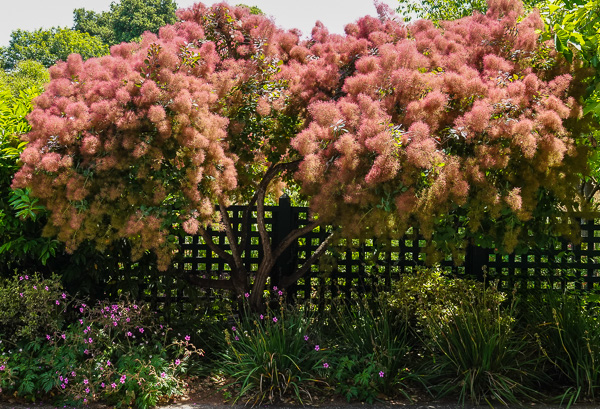
Smoke trees (or bushes) are native to warm temperate northern hemisphere, so they do well in our climate. Also, once established, they have a good tolerance for dry conditions. Though naturally multi-stemmed, smoke trees can also be trained to a single trunk. The name is derived from dramatic puffs of “smoke” which are actually panicles (branched clusters) of fading flowers.
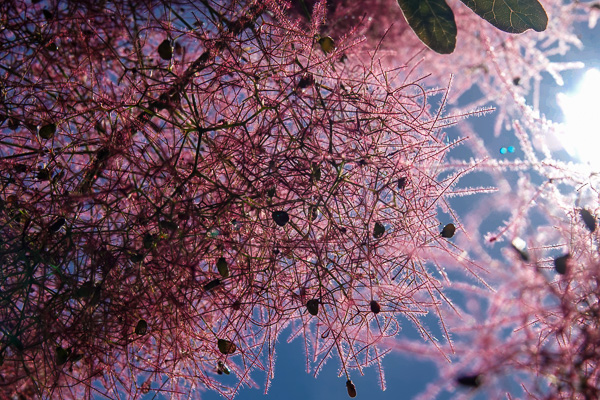
Smoke trees are at their best in poor or rocky soils; avoid overly wet conditions.
Return the way you came, turning left into the parking lot and left in at the first opening to the gardens. Trees #7 and #8 are in this area before the garden buildings.
Our Fuji apple is first espalier apple tree on the left from the parking lot. A popular hybrid developed in Japan in the 1930s and brought to market in 1962, the Fuji apple is a cross between the Red Delicious and Rawls Jennet varieties.
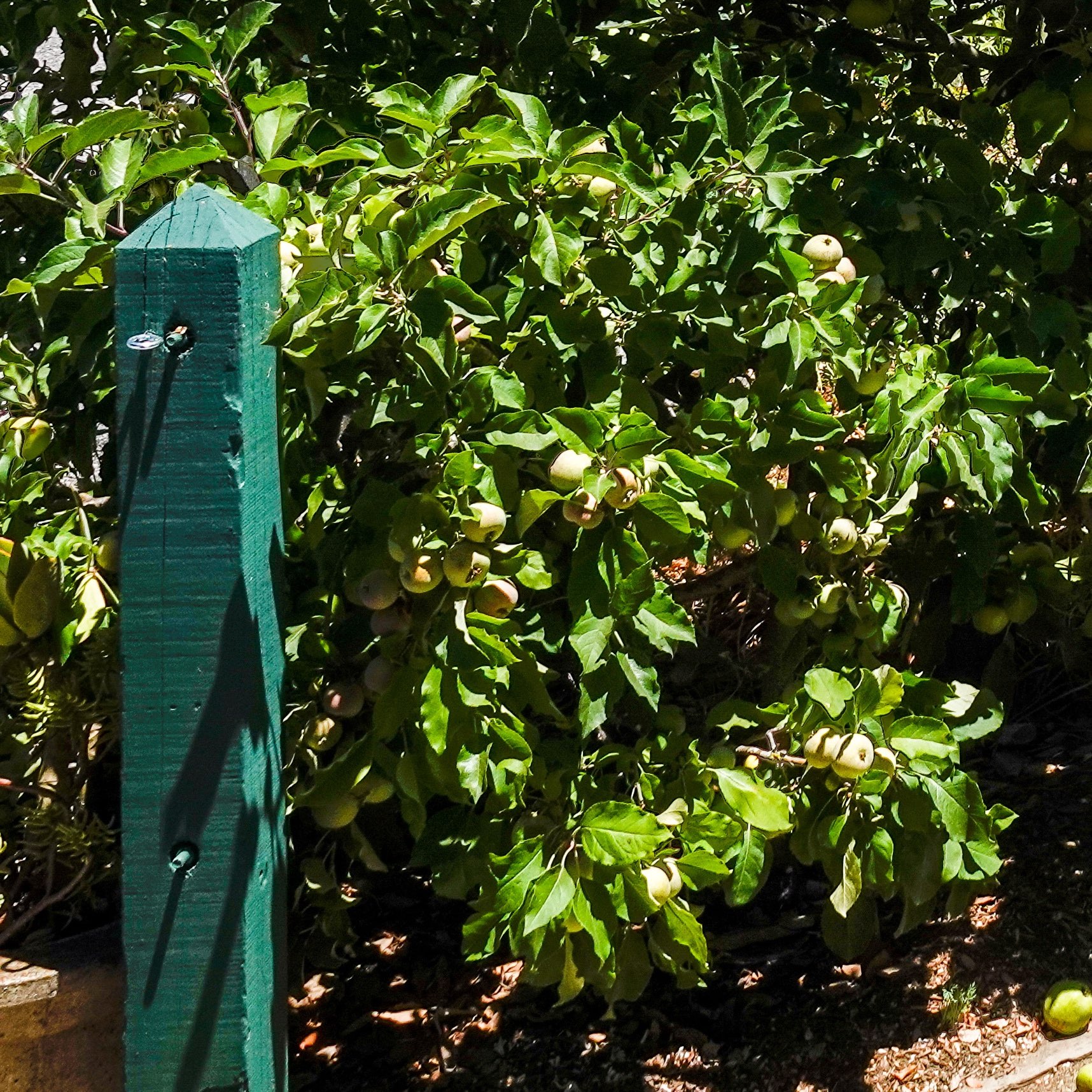
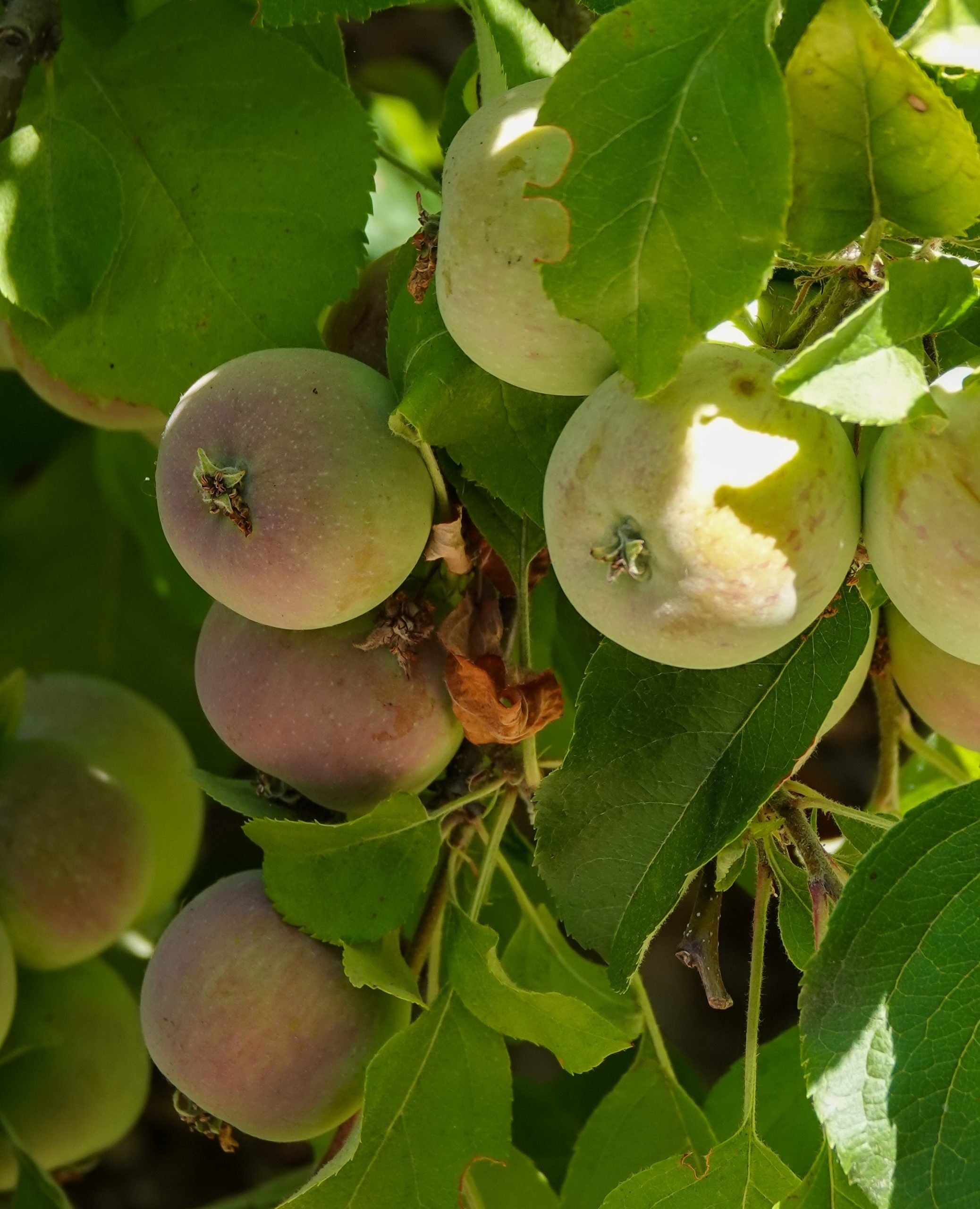
It is named after the town of Fujisaki where it was developed. These trees have been formed into an espalier which allows growing in a tight location as well as more heat, if oriented next to a building, and maximum sunlight if oriented parallel to the equator.
7. Edible Fig Black Mission (Ficus carica ‘Black Mission’)
The fig tree is behind the fence.
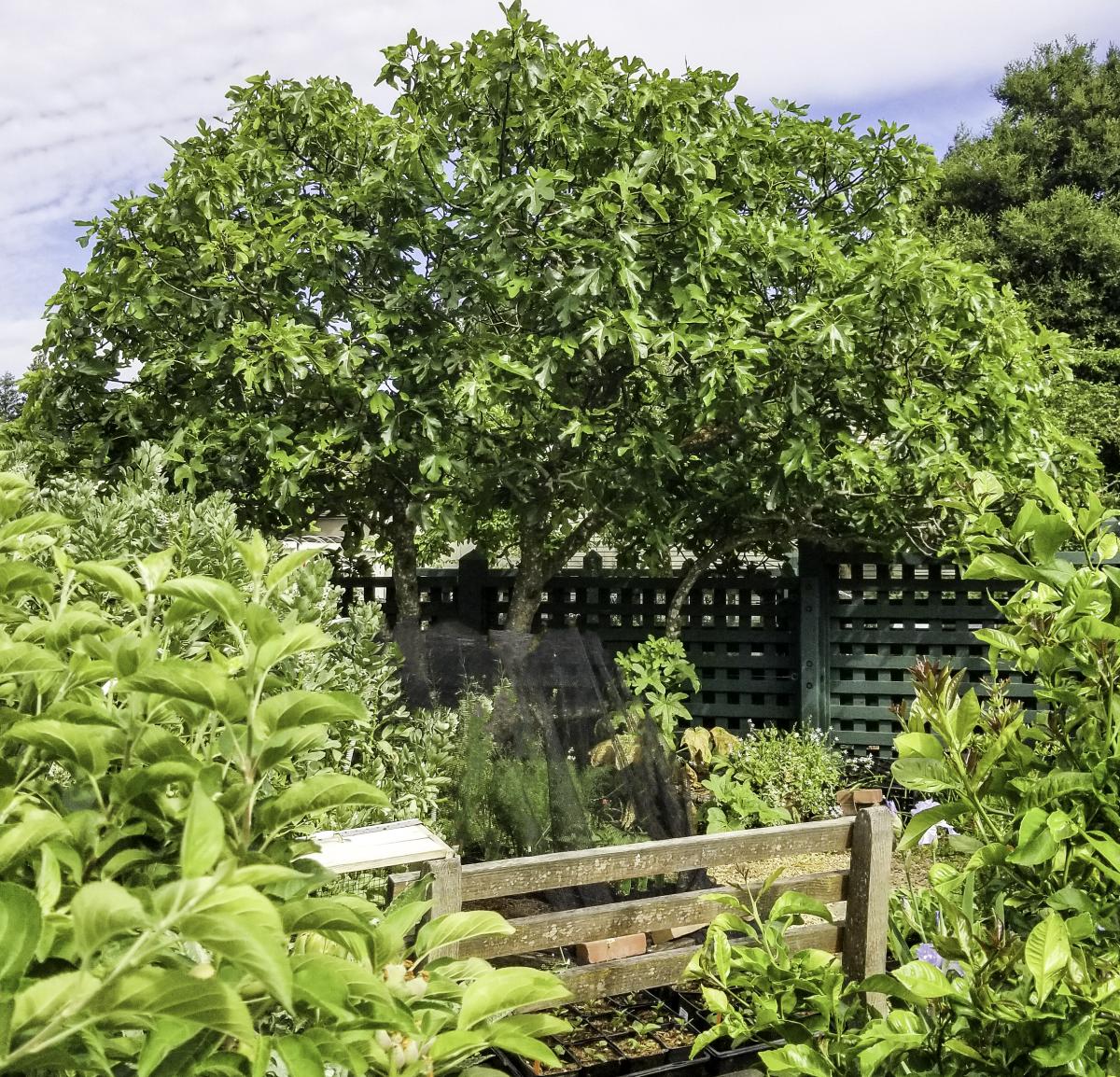
Fig is a common fruit tree in the Bay Area. They can grow to 15–30’ but can also be kept to 10’ in a large container. The ‘Black Mission’ variety produces purple-black fruit with pink flesh that is good either fresh or dried. Edible figs are one of the first plants that were cultivated by humans.
8. Cockspur Coral Tree (Erythrina crista-galli)
Continue on the path, turning right at the first opening. The coral tree is at the rear of the low brick Tea House on your left.
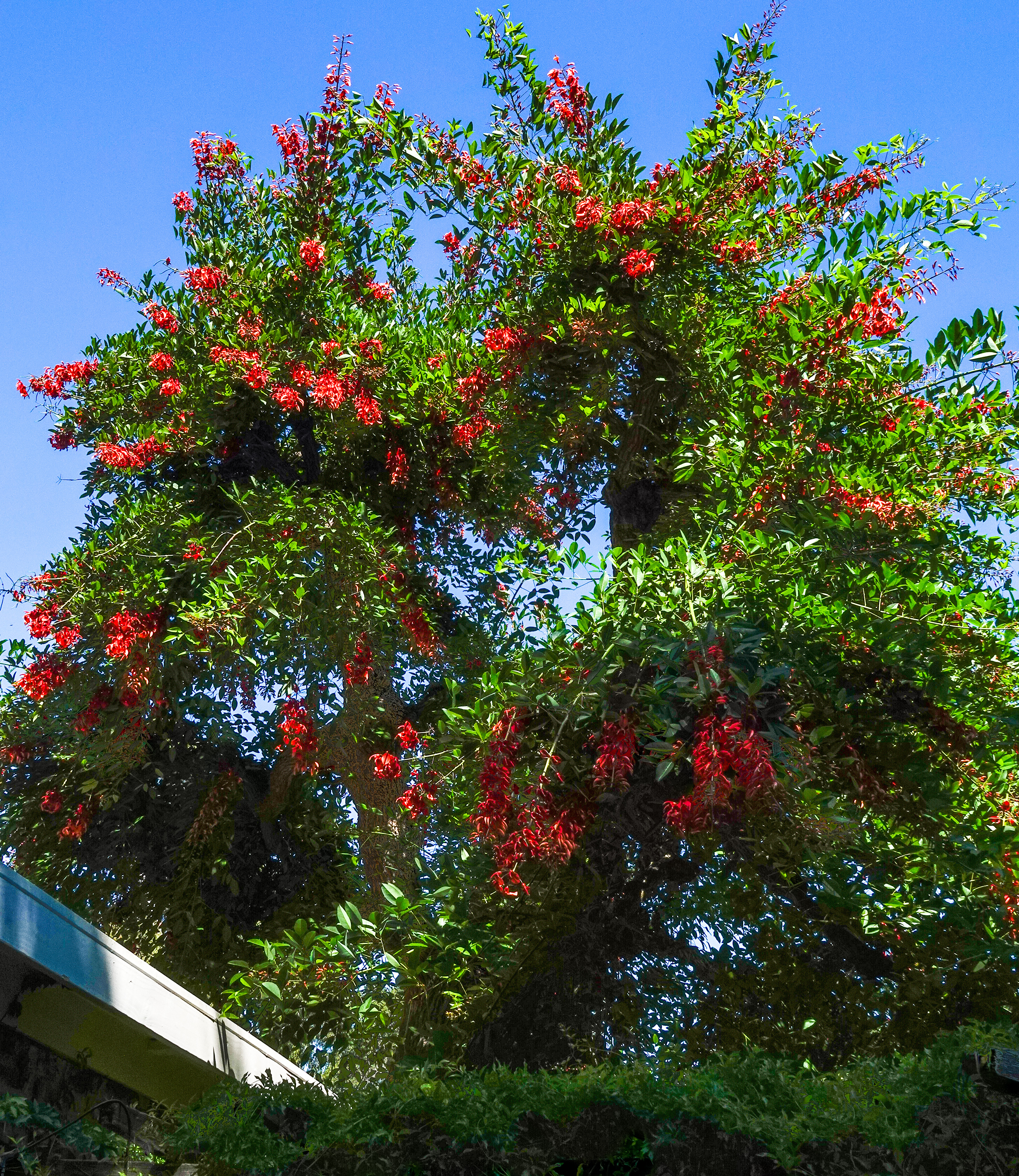
Coral tree is known for its extravagant display of flowers which have been chosen as Argentina’s national flower. The first flowers form in the spring after the leaves have unfurled.
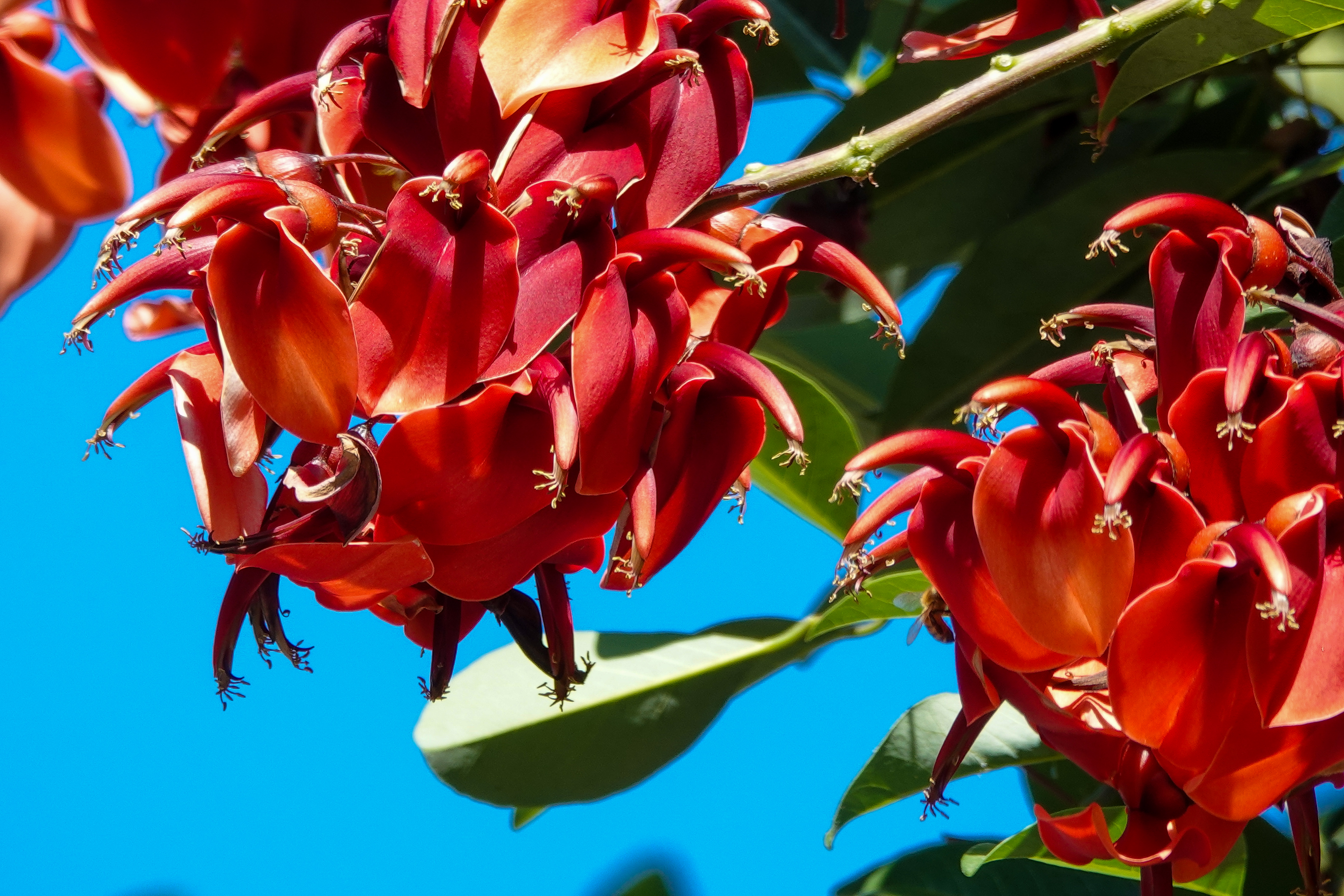
Each branch tip has a big, loose cluster of velvety, blossoms that vary in color from pink to dark red. In summer, blossoms are replaced by long bean pods. Notice the pollarding (pruning repeated year after year) at the base of new growth. This tree was planted by the Gamble family.
9. Saucer Magnolia (Magnolia x soulangeana)
Continue on the path, turning left to go to the circular drive in front of the main house. There you can turn around and see trees #10, #11, and #12.
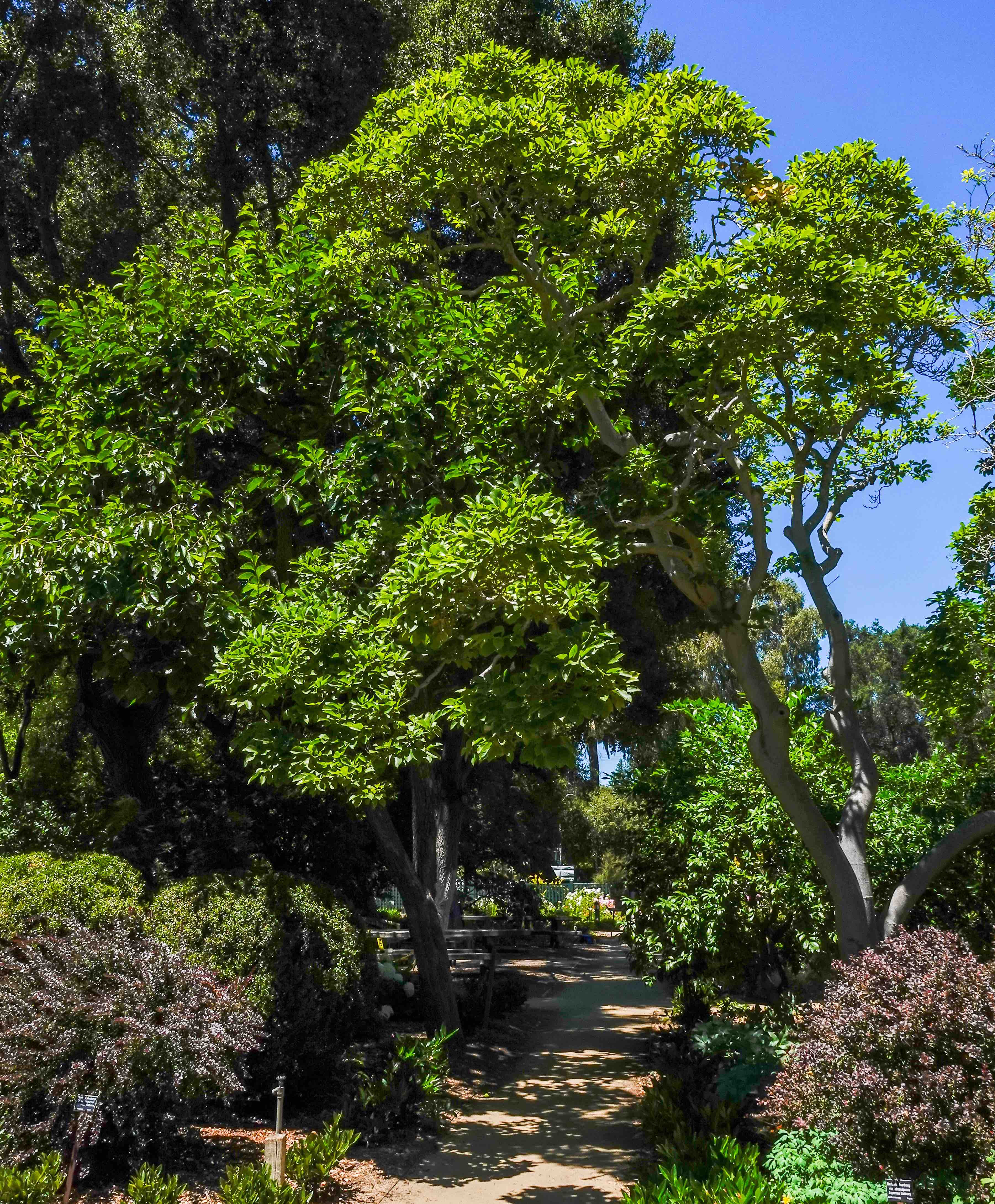
A deciduous magnolia with white to purplish-red fragrant flowers, 3–6” wide. This tree blooms from late winter into spring before the leaves emerge.
10. Magnolia 'Vulcan' (Magnolia 'vulcan')
From mid-spring, the Magnolia ‘Vulcan’ has large, fragrant cup-shaped flowers that are an intense ruby-magenta in color. Deciduous, its broad, mid-green leaves fall late in the year. In late winter and early spring, lightly fragrant flowers cover the branches before leaf-out.
Seedy, cone-like fruits follow the flowers, attracting birds.
11. Japanese Persimmon Hachiya (Diospyros kaki ‘Hachiya’)
The persimmon is on the left-hand side of the path.
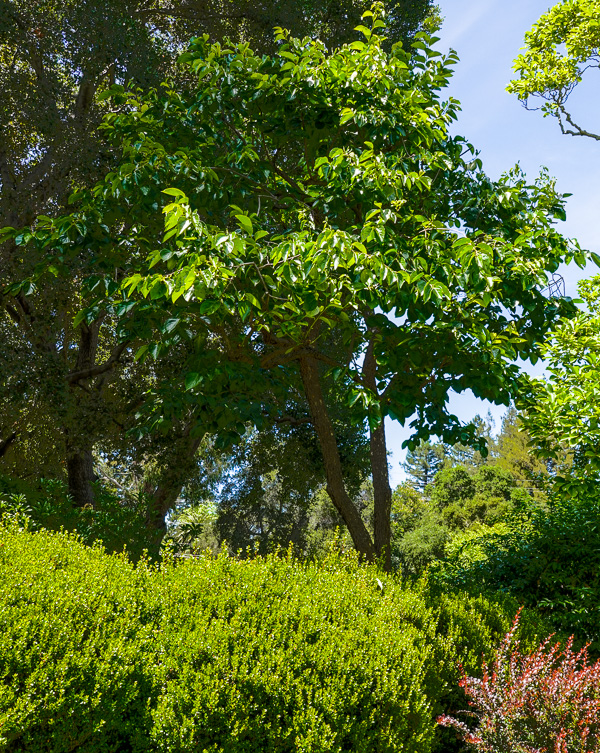
This tree produces big, slightly pointed fruit which are quite astringent until they become very soft and ripe. The fruit can be pureed and used as a replacement for applesauce in bread and other recipes. The other persimmon seen locally is the non-astringent ‘Fuyu’, which is shaped like a flattened tomato.
12. Canary Island Date Palm (Phoenix canariensis)
With your back to the path, you’ll see the palm.
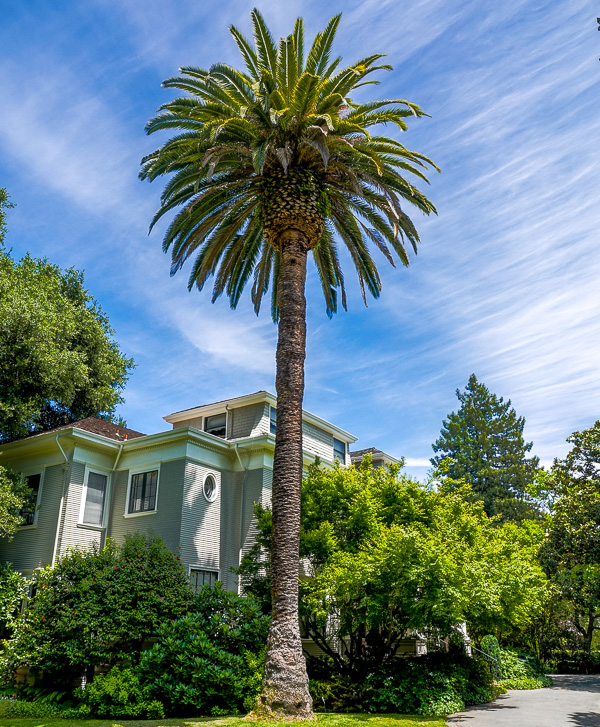
The Canary Island date palm is an ornamental relative of the edible date palm, Phoenix dactylifera. Palms are not really trees at all, rather more closely related to grasses. They grow from the top and have no woody tissue.
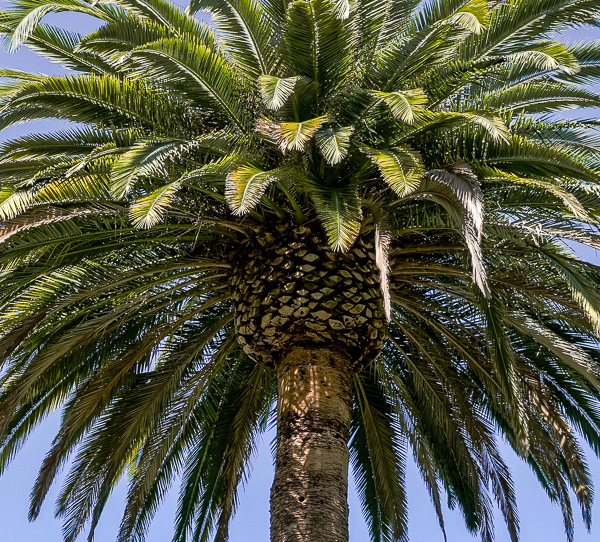
This specimen and two others on the property were planted by the Gamble family. At the time, Canary Island date palms were symbols of wealth.
13. Japanese Maple (Acer palmatum)
Walk along the circular drive so that you’re in front of the house. The maple is on the left-hand side of the front entry.
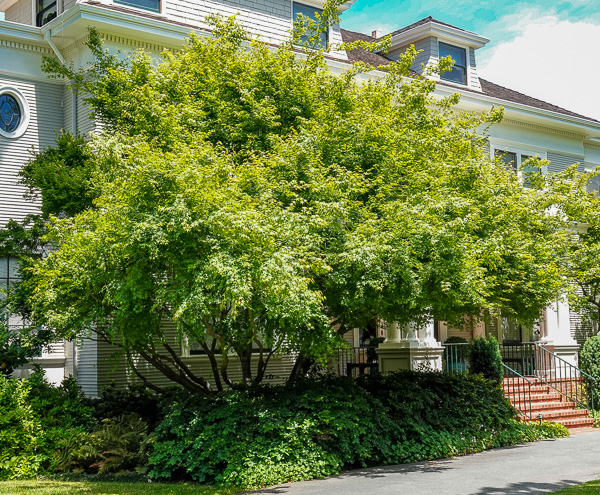
This well-formed, multi-trunked Japanese maple, and its partner on the other side of the front door, is lovely standing near the Gamble house. The house was built in 1902 for the Gamble family, who moved here from Kentucky after the eldest son enrolled at Stanford University. Daughter Elizabeth lived in the house until her death in 1981 at age 92.
14. Southern Magnolia (Magnolia grandiflora)
This magnolia is behind you on the street side of the circular drive.
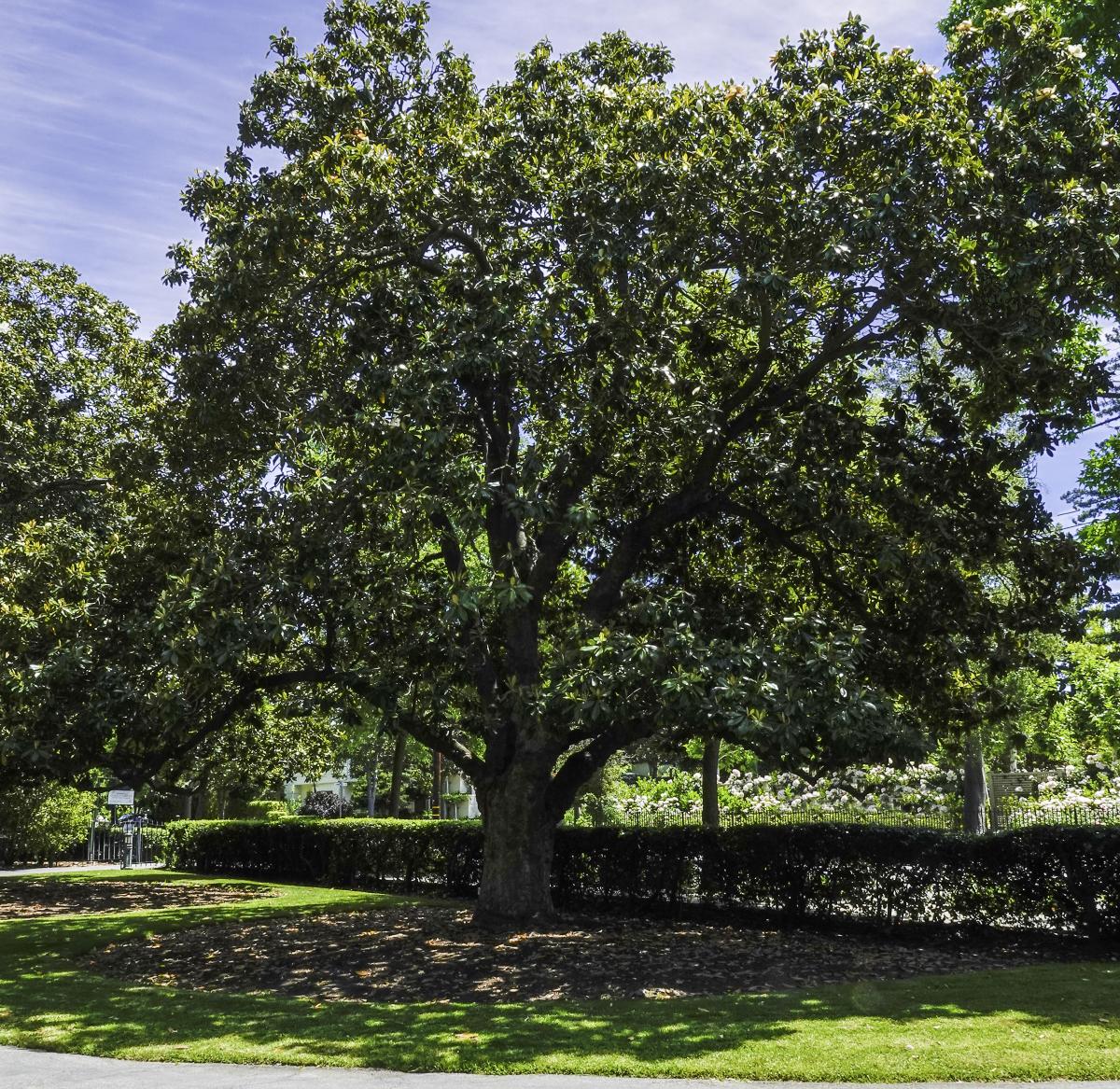
These two large old Southern magnolias are the centerpiece of the front lawn.
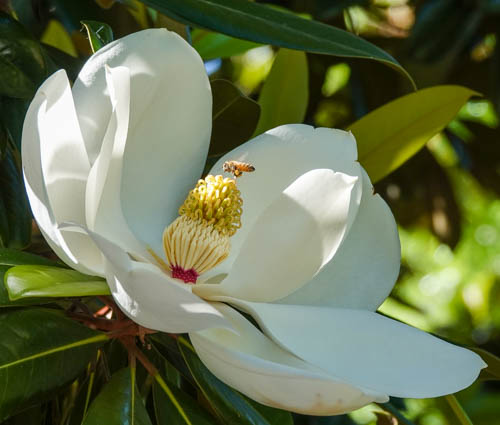
Many Southern magnolias were planted along Palo Alto’s streets in the early 1900s by the Woman’s Club of Palo Alto. Notice that the lower limbs are only a few feet above the lawn, unlike the street trees, whose lowest limbs are pruned for truck clearance.
15. Chinese Tallow Tree (Triadica sebifera)
Walk just past the corner of the house and turn left onto the path by the side of the house.
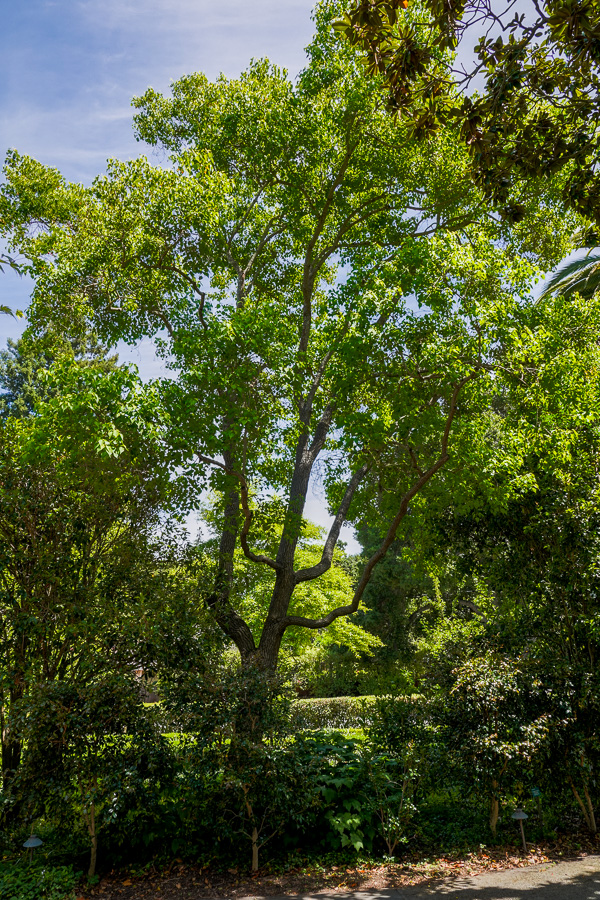
Chinese tallow trees grow to 35’ with an upright, rounded canopy and lovely heart-shaped leaves. The light green leaves of Chinese tallow trees are dense, but they flutter at the slightest breeze, giving the tree an airy look. This tree is known for its dramatic red, yellow, or purple fall color. The name “tallow tree” is derived from the Chinese practice of using the waxy coating around the seeds for making candles.
This species was a particular favorite of Elizabeth Gamble. This tree and two others along the side of the house were moved here from an estate in Woodside as mature trees.
16. Sugar Tyme Crabapple (Malus ‘Sutyzam’)
Turn right on the path into the allée and stop at the sundial, facing the fountain.
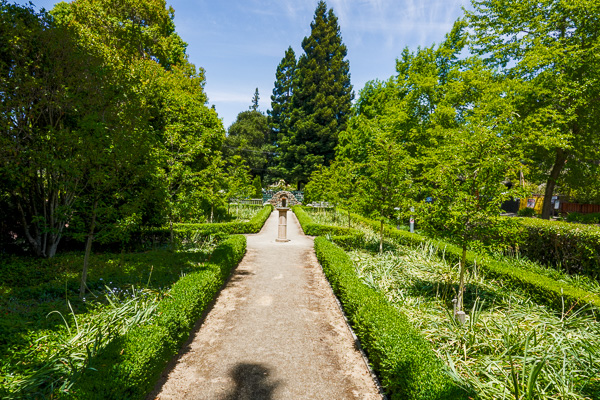
These 14 trees form an allée, the French word for a formal garden promenade punctuated by a feature at each end (fountain and bench in this case). The site was replanted in 2014, replacing the original weeping cherries which had begun to decline due to sunburn (a common issue with the weeping form) and eventually boring insects.
The tupelos are to your right, lining Churchill Ave.
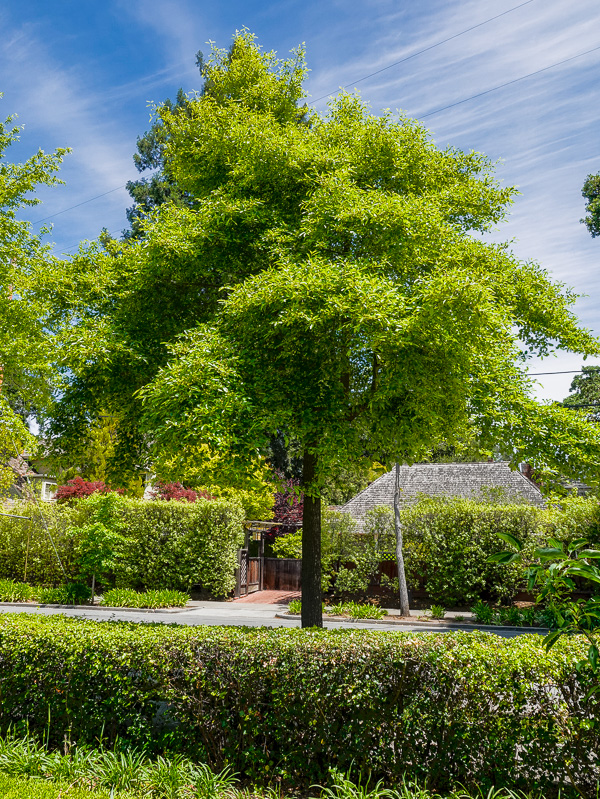
This is the primary street tree along most of the perimeter of the garden. Native to all but the most northern parts of the east coast where it is a major source of wild honey and brilliant crimson fall color. It is recommended only for irrigated sites.
18. Coast Redwood (Sequoia sempervirens)
Look down the allée, past the rose garden to the coast redwoods at the side of the parking lot.
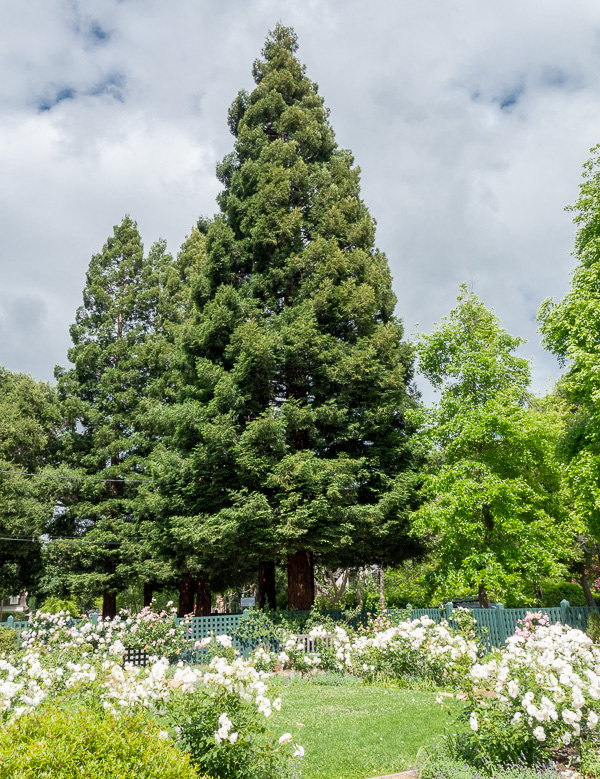
Among the world’s tallest species, Coast Redwoods can grow 3–5’ per year. Their native habitat is coastal hills and valleys where foggy weather is more prevalent. In home gardens, they often reach 70–90’ with a spread of 15–30’. They grow well next to a watered lawn in full sun to part shade. Coast redwoods are protected by the City of Palo Alto; a permit is needed to prune or remove these trees.
19. English Laurel (Prunus laurocerasus)
Walk to the fountain, turn left, and exit the allée. At the end of the path, turn around to see the laurel on your right.
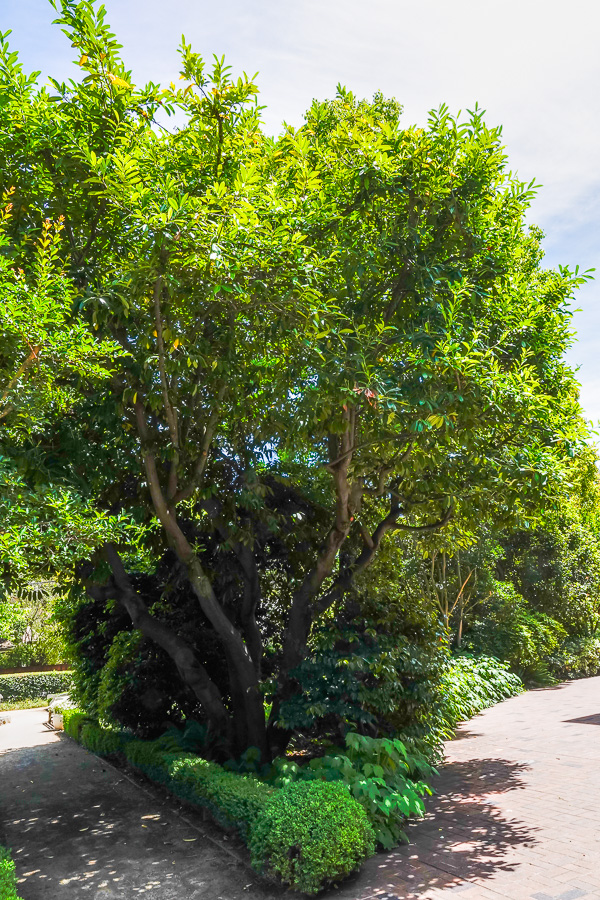
Usually a large shrub, this exceptionally large English laurel has been trained as a tree. It is very tolerant of drought and shade and is relatively pest-free.
20. Crape Myrtle (Lagerstroemia x ‘Tuscarora’)
Walk a few steps up the path toward the Carriage House and the crepe myrtles are on your right.
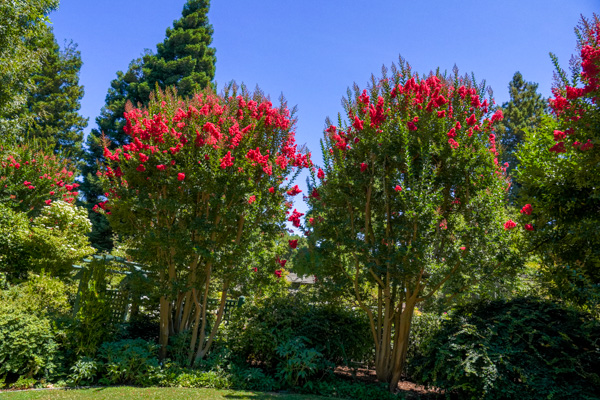
This multi-stemmed tree is one of many crape myrtles along this path from Waverley Street to the back parking lot. They are relatively problem-free trees with showy summer flowers and brilliant fall leaf color. All crape myrtles bloom on new wood, so pruning in winter or early spring is important to increase flowering.
21. Shumard Oak (Quercus shumardii)
The oak is just in front of the Carriage House.
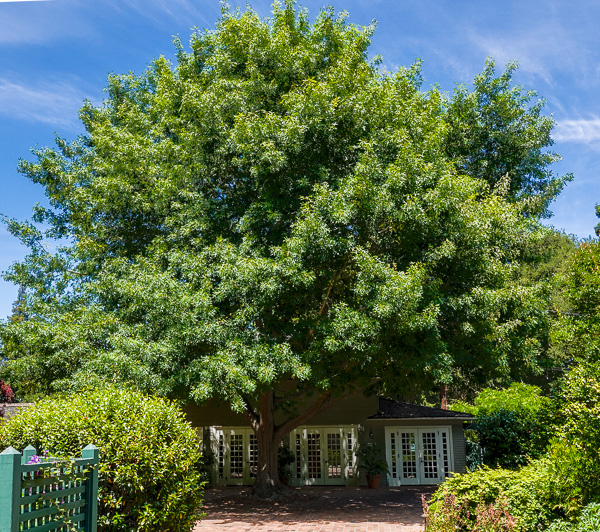
A deciduous oak closely related to the red oak, the high-branching broad canopy makes it an excellent shade tree. In fall, the deeply lobed leaves will turn a vibrant reddish-brown before dropping. Shumard oak is native to the Midwest and Southeast U.S.
22. Japanese Maple (Acer palmatum, cultivars & varieties)
Walk toward the Tea House and you’ll see the maples just before entering the courtyard.
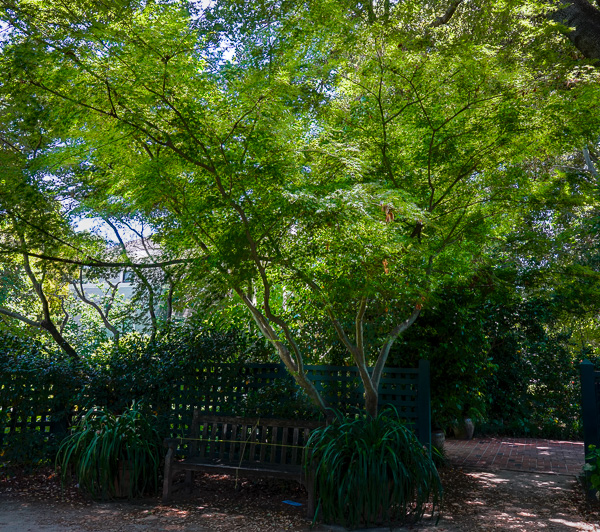
This bed and the adjacent beds provide a glimpse of the great differences in Japanese maples. Note the variety in size, leaf color, and leaf shape. Look for markers in to tell you the cultivar name of each tree.
The red oak can be seen from the courtyard, looking back at the main house.
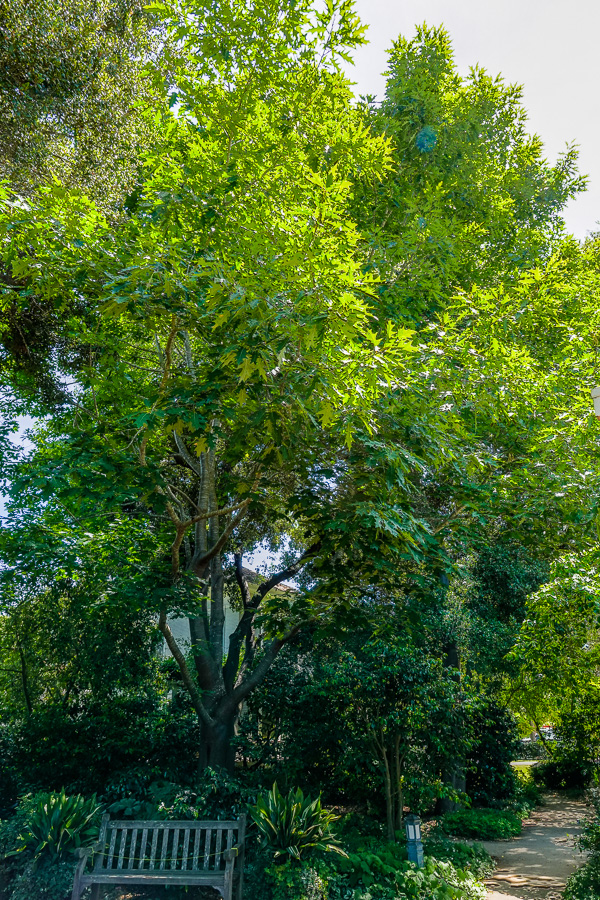
Named for its spectacular red fall color, this deciduous oak is native to the eastern half of the U.S. The acorns of red oaks take two years to develop; the first year they are small and partially formed and in the second year they elongate and mature.
24. Eddie’s White Wonder Dogwood (Cornus x ‘Eddie’s White Wonder’)
The dogwood is at the left-hand corner of the Tea House.

This tree is a hybrid between the flowering dogwood (Cornus florida) and the Pacific dogwood (Cornus nuttallii). It is easier to grow and has larger flowers than either of its parents.
25. Paperbark Maple (Acer griseum)
Walk back to the rear of the house, into the garden room. The maple is to the left of the back porch.
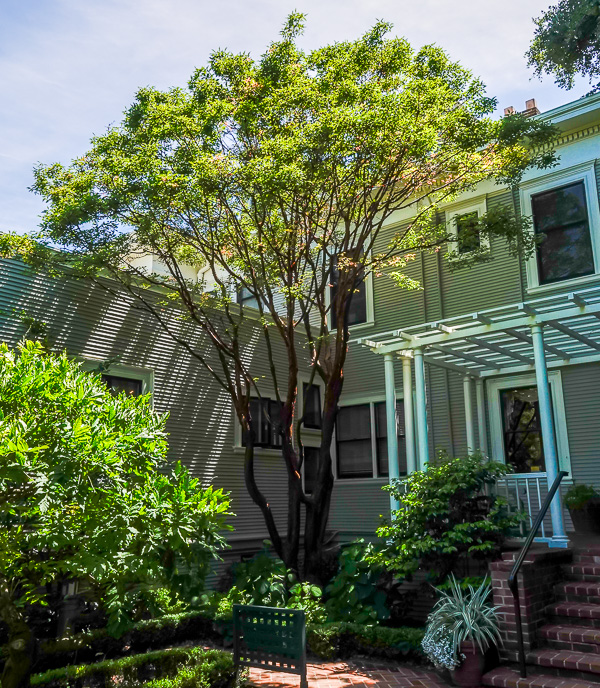
This tree is best distinguished by its reddish, peeling, paper-like bark.
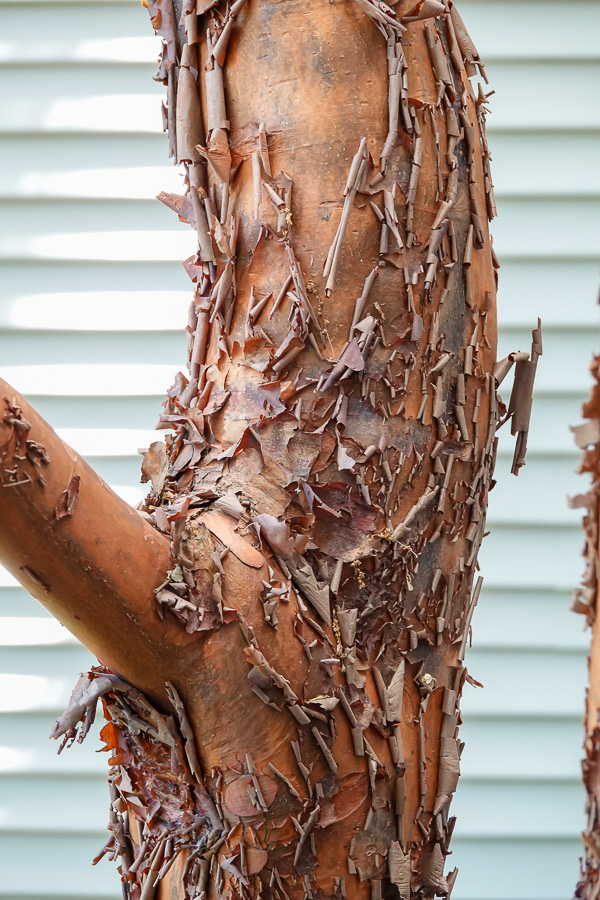
Peeling bark is a way for the tree to shed toxins; many birch trees use the same technique. The foliage is a brilliant red in the fall.
26. Coast Live Oak (Quercus agrifolia)
Walk back towards the Teahouse and out into the garden. The coast live oaks border Waverly St.
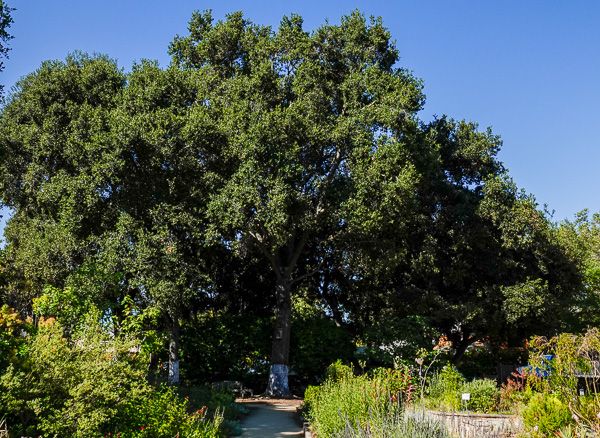
The coast live oak (Quercus agrifolia) is a large oak tree native to the Pacific Coast of California and is an important tree in California’s cultural landscape. Live oaks are protected by the City of Palo Alto; a permit is needed to prune or remove these trees.
The coast live oak can grow to up to 80 feet tall. Its bark is thick and grows gnarled and deeply fissured as the tree gets older, with twisted and irregular branches. The live oaks are a group of evergreen oaks—they do not shed their leaves in the winter. In the spring, the oak produces small catkin flowers; the mild coastal weather ensures that the flowers can bloom for many months.
The coast live oak was an extremely important tree to the California Native Americans. The acorns produced by the oak were a primary food source of many native groups, including the Ohlone, Kameyaay, and Cahuilla people. After harvesting the acorns, they were ground into a flour-like paste. The tannins (a bitter phenolic compound) from the acorns were leached out by placing the paste in a cloth bag and washing it in water several times. After leaching, the acorn paste was cooked and eaten as a mush called wiiwish. Additionally, the wood from the coast live oak was used to make spoons and bowls, and the red bark of the tree was used to dye clothing.
Like many California oaks, the coast live oaks are vulnerable to Sudden Oak Death, a recent disease caused by the plant pathogen Phytophthora ramorum. While the disease is not harmful to humans, it ravages oak forests and nurseries. The white ‘paint’ you see on the trunks of our trees is a lime solution which we hope will reverse or at least slow down the disease.
That’s the end of our tour. We hope you enjoyed it. Please free to send us your comments, ideas and any suggestions you might have for future tours to [email protected].
Did you know that Gamble Garden is a 501c(3) non-profit organization? We receive no city, state or federal money and we charge no admission fee. All of our income derives from memberships, donations and special events. Please consider becoming a member and/or donating so that Gamble Garden can continue to be a place of respite, beauty and education for our community. You can find details at https://www.gamblegarden.org/
![]() For more information about Canopy, please visit canopy.org.
For more information about Canopy, please visit canopy.org.
Photos courtesy of Doug Kalish and Matthew Buynoski.
A brief history of Trees at Gamble
Some of today’s trees, including a few coast live oaks and the eucalyptus, preceded the Gambles’ purchase of the property in 1902. Elizabeth’s family first planted fruit trees in a backyard orchard and installed status-signifying Canary date palms and Southern magnolias on the public-facing sides of the family home. Landscaping efforts in the late 1930s and again in the late 1940s/early 1950s brought a number of native, Asian and rare specimens to the property, as Elizabeth was a keen collector and experimenter. When the garden entered public trust in 1986, certain trees—due to overgrowth, poor condition, danger to humans, and aesthetic reasons—were removed, and new specimens were planted according to a plan that served historic, aesthetic and contemporary public needs.
